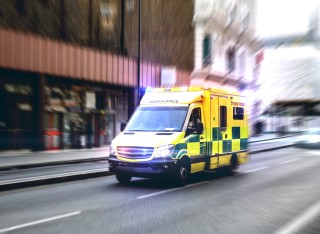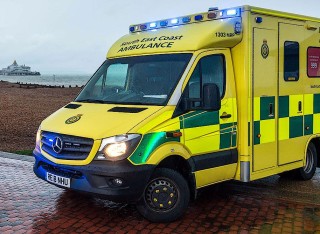
Dr Lucie Ollis
About
Biography
After completing my BSc Psychology at the University of the West of England in 2016, I moved to the University of Surrey to continue my interests in Health Psychology. In September 2017 I finished the MSc in Health Psychology at the University of Surrey and went on to complete my PhD in Health Psychology in October 2021. The title of my PhD was: "A Quantitative Investigation Exploring the Psychological and Physiological Aspects of Individual Resilience, Rumination and Recovery". I also completed my Stage 2 in Health Psychology to become HCPC registered.
Alongside my PhD, I worked as a Research Assistant for Your Healthcare CIC, working on a variety of NHS research projects including service users, psychologists, nurses, physios and infection control. This sparked my interest for research within the NHS and the cross over between academic research and research in healthcare organisations.
From October 2021 to October 2023 I worked as a Research Fellow on an NIHR funded feasibility trial, testing the use of video livestreaming during trauma incidents (999 callers to emergency dispatchers). Currently, I work as a Lecturer in Psychology in the School of Psychological Sciences. I teach Critical Thinking, Research Methods (Qualitative and Quantitative), Health Psychology and Dissertation modules. I am also part of the module team for various other BSc Psychology modules and the Health Psychology Research Group.
University roles and responsibilities
- Lecturer in Psychology
My qualifications
News
ResearchResearch projects
BACKGROUND: Timely dispatch of appropriate emergency resources after traumatic incidents is critical to prevent death and improve outcomes. Dispatch priorities mostly rely on verbal 999-caller information and up to 50% air/25% road ambulance deployments are inappropriate. Video from scene is recommended but lacks evidence. GoodSAM enables video streaming to dispatchers using callers' smartphone cameras. RESEARCH QUESTION: Is it feasible to conduct a future RCT to assess the clinical and cost effectiveness of using GoodSAM to improve targeting of emergency resources? OVERALL AIM: To assess the feasibility of implementing and evaluating GoodSAM in a definitive RCT. OBJECTIVES: 1. To obtain data to design a definitive RCT (e.g. event & screening rates, effect size/precision for outcomes, health economic data) 2. To test trial processes including randomisation and data collection 3. To conduct a process evaluation to test acceptability, feasibility and outcomes of use of GoodSAM from provider and public perspectives (e.g. training, video feasibility and acceptability, psychological harm to callers and/or dispatch staff). DESIGN/SETTING: Feasibility RCT in one Emergency Operations Centre in SE England METHODS: INCLUSION: All 999 calls involving Category 1 or 2 trauma; All calls screened by Helicopter Emergency Medical Services dispatchers involving trauma. EXCLUSION: All emergencies of a suspected medical origin. RANDOMISATION: Calls in 6 observation weeks (42 days; 84 shifts) allocated 1:1 by shift. CONTROL: Standard care NHS Pathways dispatch protocol with a 999-caller (verbal only) INTERVENTION: As per control group until call handler has determined dispatch priority and ambulance dispatched without delay. GoodSAM streaming will then begin (via SMS text link) and ambulance dispatch may be adjusted. PRIMARY OUTCOME: Decision regarding feasibility of undertaking a definitive RCT based on pre-defined criteria (willingness/ability to stream footage, signal of effect; and risk of psychological harm in callers/staff). SECONDARY OUTCOMES: Speed of appropriate emergency dispatch (using time-stamped data from 999 call to appropriate deployment; appropriateness based on expert consensus criteria and using data up to 3 months post-incident), stand-down rate, missed jobs, further resources requested from scene. SAMPLE SIZE: Conservative event rate = 250 trauma incidents (125 allocated to intervention) allowing estimate of true rate within precision of +/-0.75 events/day; and of appropriateness of response with a standard error of <5%. A health economic analysis will be undertaken to inform design of a subsequent full economic evaluation. The process evaluation will include analysis of streaming usage data; observation of control room processes (e.g. fidelity to study protocol); and survey and interviews with staff and 999 callers. A sub-study in an inner-city site will examine acceptability of GoodSAM in a population with greater diversity. ANALYSIS: estimates and confidence intervals of key rates. A framework approach will be used to analyse qualitative data. TIMELINE: 18 months. IMPACT/DISSEMINATION: This study will determine if a subsequent definitive trial is feasible; and produce novel data about psychological harm associated with witnessing/viewing trauma incidents. We will disseminate findings via academic and lay outputs. If effective, GoodSAM could be scaled up nationally/used for other incidents e.g. multi-agency.
Research projects
BACKGROUND: Timely dispatch of appropriate emergency resources after traumatic incidents is critical to prevent death and improve outcomes. Dispatch priorities mostly rely on verbal 999-caller information and up to 50% air/25% road ambulance deployments are inappropriate. Video from scene is recommended but lacks evidence. GoodSAM enables video streaming to dispatchers using callers' smartphone cameras. RESEARCH QUESTION: Is it feasible to conduct a future RCT to assess the clinical and cost effectiveness of using GoodSAM to improve targeting of emergency resources? OVERALL AIM: To assess the feasibility of implementing and evaluating GoodSAM in a definitive RCT. OBJECTIVES: 1. To obtain data to design a definitive RCT (e.g. event & screening rates, effect size/precision for outcomes, health economic data) 2. To test trial processes including randomisation and data collection 3. To conduct a process evaluation to test acceptability, feasibility and outcomes of use of GoodSAM from provider and public perspectives (e.g. training, video feasibility and acceptability, psychological harm to callers and/or dispatch staff). DESIGN/SETTING: Feasibility RCT in one Emergency Operations Centre in SE England METHODS: INCLUSION: All 999 calls involving Category 1 or 2 trauma; All calls screened by Helicopter Emergency Medical Services dispatchers involving trauma. EXCLUSION: All emergencies of a suspected medical origin. RANDOMISATION: Calls in 6 observation weeks (42 days; 84 shifts) allocated 1:1 by shift. CONTROL: Standard care NHS Pathways dispatch protocol with a 999-caller (verbal only) INTERVENTION: As per control group until call handler has determined dispatch priority and ambulance dispatched without delay. GoodSAM streaming will then begin (via SMS text link) and ambulance dispatch may be adjusted. PRIMARY OUTCOME: Decision regarding feasibility of undertaking a definitive RCT based on pre-defined criteria (willingness/ability to stream footage, signal of effect; and risk of psychological harm in callers/staff). SECONDARY OUTCOMES: Speed of appropriate emergency dispatch (using time-stamped data from 999 call to appropriate deployment; appropriateness based on expert consensus criteria and using data up to 3 months post-incident), stand-down rate, missed jobs, further resources requested from scene. SAMPLE SIZE: Conservative event rate = 250 trauma incidents (125 allocated to intervention) allowing estimate of true rate within precision of +/-0.75 events/day; and of appropriateness of response with a standard error of <5%. A health economic analysis will be undertaken to inform design of a subsequent full economic evaluation. The process evaluation will include analysis of streaming usage data; observation of control room processes (e.g. fidelity to study protocol); and survey and interviews with staff and 999 callers. A sub-study in an inner-city site will examine acceptability of GoodSAM in a population with greater diversity. ANALYSIS: estimates and confidence intervals of key rates. A framework approach will be used to analyse qualitative data. TIMELINE: 18 months. IMPACT/DISSEMINATION: This study will determine if a subsequent definitive trial is feasible; and produce novel data about psychological harm associated with witnessing/viewing trauma incidents. We will disseminate findings via academic and lay outputs. If effective, GoodSAM could be scaled up nationally/used for other incidents e.g. multi-agency.
Teaching
I completed the Graduate Certificate in Learning and Teaching in July 2020. I currently work as a Lecturer in Psychology and are part of the following module teams:
- Introduction to Statistics and Data Analysis (BSc/MSc Conversion)
- Qualitative Psychology (BSc)
- Health Psychology (BSc)
- Psychology Dissertation (BSc)
- Professional Training Year Module (BSc)
- Clinical Psychology and Mental Health (BSc)
- Social Psychology with Research Methods (BSc/MSc Conversion)
- Classics in Personality Theory (BSc)
- Personality, Intelligence and Psychopathology (BSc)
- The Psychology of Global Challenges (BSc)
- Psychological Aspects of Healthcare (Health Psych. MSc)
Publications
Previous research has highlighted a lack of continuity of care when young people with a neurodevelopmental condition make the transition from children's to adult specialist healthcare services. A lack of planning, consistency, and availability of adult services has been found to lead to; increased anxiety, poor health outcomes, reduced support and some young people not receiving healthcare. The majority of transition research has focused on what health professionals consider important in the transition process, rather than focusing on the experiences of the young people and those closest to them. Our objective was to gather evidence from young people (and their families) who had experienced transition from children's to adult specialist healthcare services through semi‐structured interviews. Volunteers were recruited from two London boroughs. All young people were aged between 18 and 25 years with a neurodevelopmental condition (Attention Deficit Hyperactivity Disorder, Autism Spectrum Disorder and/or an Intellectual Disability). Overall, we interviewed six young people with support from a family member. Five further family members were interviewed on behalf of the young person. In total, ten semi‐structured interviews were transcribed verbatim and analysed using Interpretative Phenomenological Analysis. Four themes emerged from the analysis: (a) Parents as advocates, (b) Availability of adult's specialist health and social care services, (c) Lack of information sharing and (d) Transition as a binary, abrupt change. Our findings suggest the transition experience could be improved by changing service specifications to incorporate assessment and handover across the age range of 16–20 years. Additionally, statutory services should understand and provide the coordination role now offered by parents in transition. We suggest future research could evaluate the feasibility of a patient‐owned online information sharing tool with information about relevant services for young people and their families.
This chapter examines the growing literature on student–staff partnerships. Within the context of higher education, conceptualising students as partners is a way for students and staff to work together to enhance teaching and learning experiences. These partnerships can be characterised in a variety of ways and may occur in many different educational settings. Students can take on a number of different roles, including consultant, co-researcher, pedagogical co-designer and representative. This chapter considers how to define what a student–staff partnership is and explores the benefits of partnership approaches, including enhanced student engagement, enhanced student employability and improved student–staff relations. It also examines purported challenges such as funding and time constraints, and the difficulty of power relations between staff and students.

